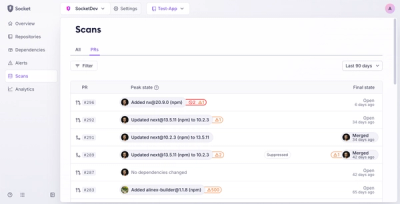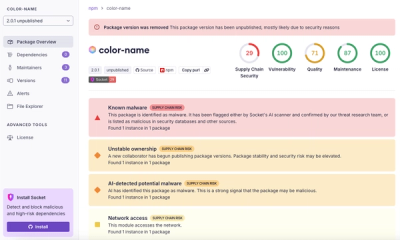
Product
Introducing Pull Request Stories to Help Security Teams Track Supply Chain Risks
Socket’s new Pull Request Stories give security teams clear visibility into dependency risks and outcomes across scanned pull requests.
@igloosoftware/web-sdk
Advanced tools
A front end SDK for integration with Igloo apps and widgets
A front end SDK for integration with Igloo apps and widgets
The Web SDK project is designed as an NPM package that can be imported into any of the various apps and widgets of Igloo. It provides common methods and functionality such as user auth, making API calls, snackbar notifications, etc.
To set up the project locally for development:
git clone https://github.com/igloosoftware/web-sdk.git
npm install
To use the sdk in your Igloo apps and widgets, run the following in your project folder:
npm i @igloosoftware/web-sdk
You can then import any required methods into your project as usual:
import { getAuthInfo, useSnackbar } from "@igloosoftware/web-sdk";
To publish a new version of the project, you will first need to configure npm and login to your account:
npm loginnpm config list
to see your current settings or run
npm config set registry="https://registry.npmjs.org/" to set your registry
if needed."version": "0.1.45" becomes "version": "0.1.46" for a patch update. Make
sure you ran npm i after changing the version.npm run buildnpm run publish. You should get an email
from npm shortly to confirm that a new version was successfully published.
Please note that it is likely that while running npm run publish you will
likely get a warning and a couple of errors in the console. As long as you
got a publish confirmation error - ignore them. Also you can go to
npm site and check is
your version is up.web repo and bump
@igloosoftware/web-sdk version in package.json file to match the one you
deployed. Do not forget to run npm i before pushing your version changes.FAQs
A front end SDK for integration with Igloo apps and widgets
We found that @igloosoftware/web-sdk demonstrated a not healthy version release cadence and project activity because the last version was released a year ago. It has 8 open source maintainers collaborating on the project.
Did you know?

Socket for GitHub automatically highlights issues in each pull request and monitors the health of all your open source dependencies. Discover the contents of your packages and block harmful activity before you install or update your dependencies.

Product
Socket’s new Pull Request Stories give security teams clear visibility into dependency risks and outcomes across scanned pull requests.

Research
/Security News
npm author Qix’s account was compromised, with malicious versions of popular packages like chalk-template, color-convert, and strip-ansi published.

Research
Four npm packages disguised as cryptographic tools steal developer credentials and send them to attacker-controlled Telegram infrastructure.